The Google Nexus 6P Review
by Andrei Frumusanu on December 16, 2015 8:00 AM ESTSystem & CPU Performance
The Nexus 6P comes with a Snapdragon 810 designed by Qualcomm. This is a big.LITTLE 4x A53 @ 1.55GHz + 4x A57 @ 1.95GHz SoC. As we’ve hopefully come to be very familiar with the chipset over the last couple of months, the key characteristics with which the 6P can differentiate itself from other Snapdragon 810 devices is through software optimizations. In particular the fact that the Nexus 6P comes with Android 6.0 Marshmallow should allow it to be able to showcase some improvements which we’ll dive into a bit later.
First we start by comparing performance of some of our browser-based benchmarks. These are predominantly Javascript tests which require large single-core performance out of the device’s SoCs.
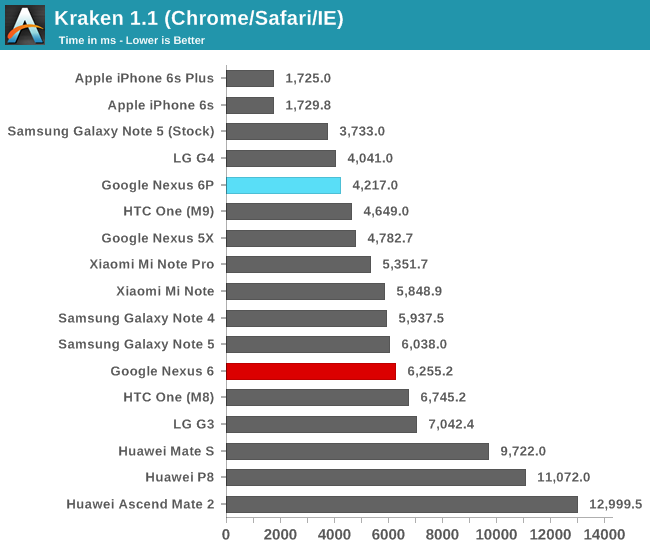
In Kraken the Nexus 6P is able to showcase a very good score that’s only beat by, oddly enough, the LG G4. As we’ve come to discover over the past year OEM browser libraries play a large role in device performance, even though we’re using the same Chrome build across different devices we see large differences in performance even within devices who employ the same SoC. It’s relatively unnerving to see this fragmentation in the ecosystem and in particular Chrome performing so differently across devices.
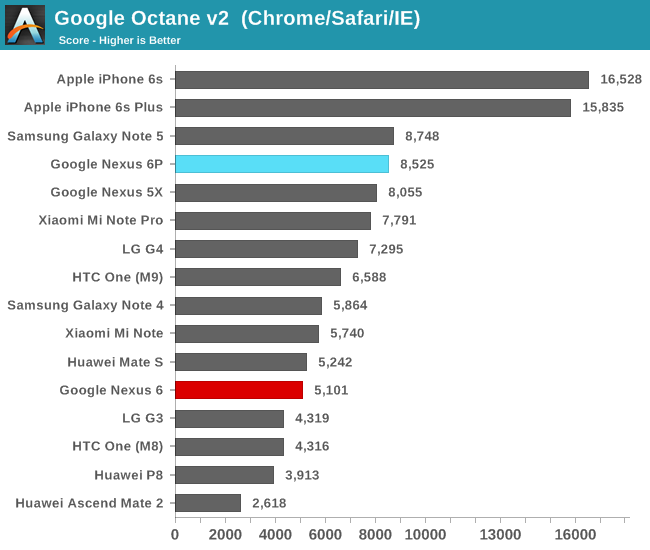
In Octane the Nexus 6P again performs very well, this time again beating our other devices such as the HTC One M9 or the Xiaomi Mi Note Pro. Among Android devices, only the Galaxy Note 5 - which on Octane is able to show equal performance as it does in its optimized stock browser - is able to beat it.
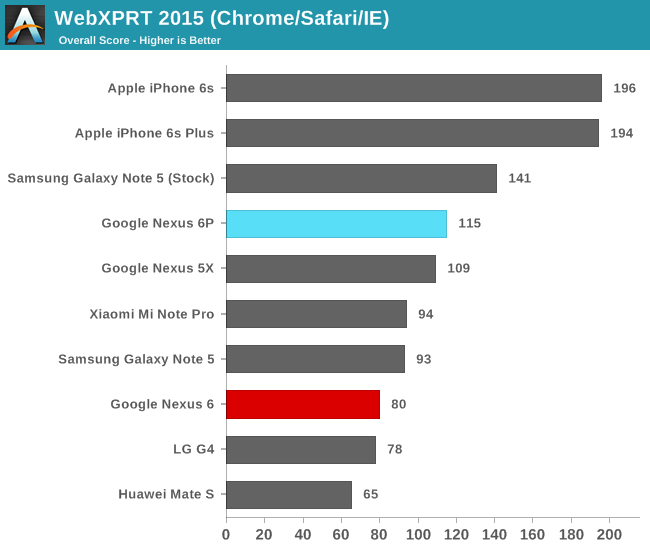
On WebXPRT again we see the 6P performs extremely well among Android devices, only being able to be beat by Samsung’s Exynos 7420 devices in the stock browser.
Continuing onto our system benchmarks, we start with Basemark OS II 2.0 from Basemark (formerly Rightware).

In the web test the Nexus 6P is yet again found at the high-end of the charts as it is able to provide good numbers. As we’ve seen in reviews such as on the Mate S it’s not necessarily raw performance that is demanded in these tests but also performance latency which plays a big role.
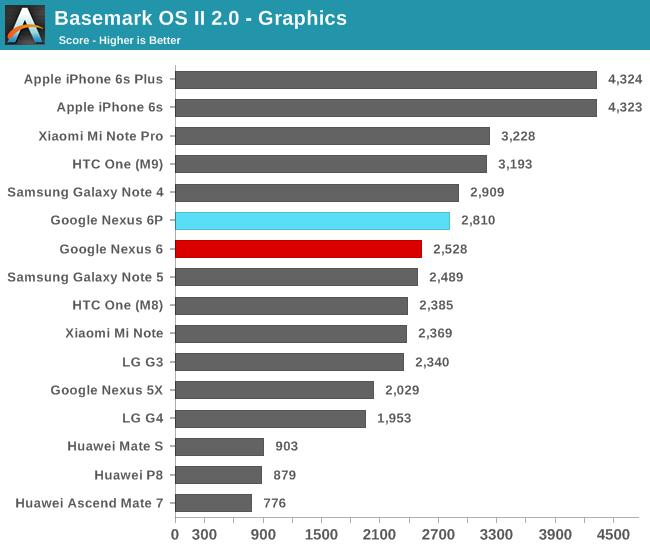
The graphics sub-test of Basemark has always been kind to the Adreno GPU so here again we see the Nexus 6P perform well, although not quite up to par with the other Snapdragon 810 devices we’ve tested in the past.
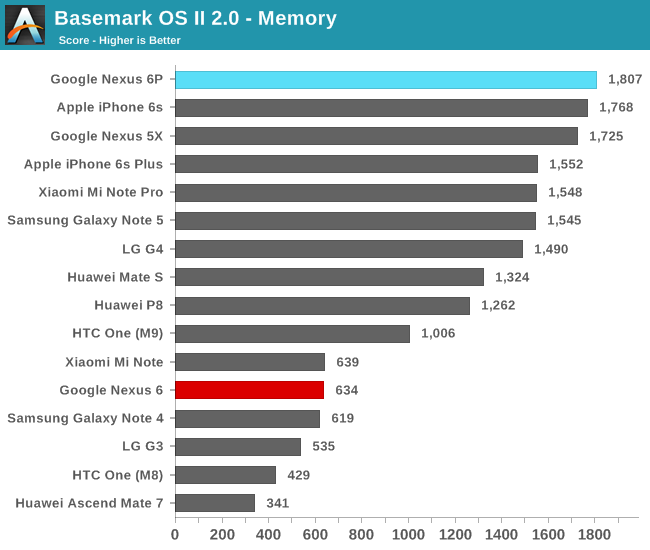
The Nexus 6P comes in a surprising first place on Basemark OS’s memory test. Again this is a mainly NAND-limited test but in contrast to our other synthetic test, performance and access patterns try to simulate more real-world applications.
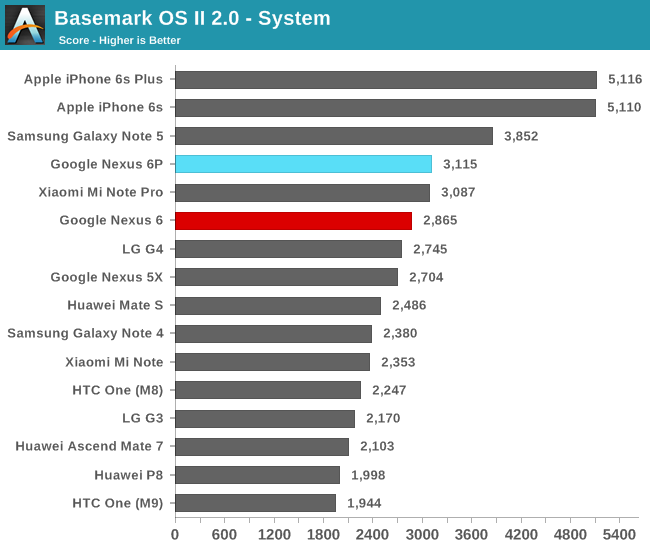
While the other tests try to test more realistic workloads, the system benchmark is all about measuring peak performance in a given set of scenarios. Here the Nexus 6P fares similarly to the Xiaomi Mi Note Pro but falls behind Exynos 7420 devices such as the Note 5.
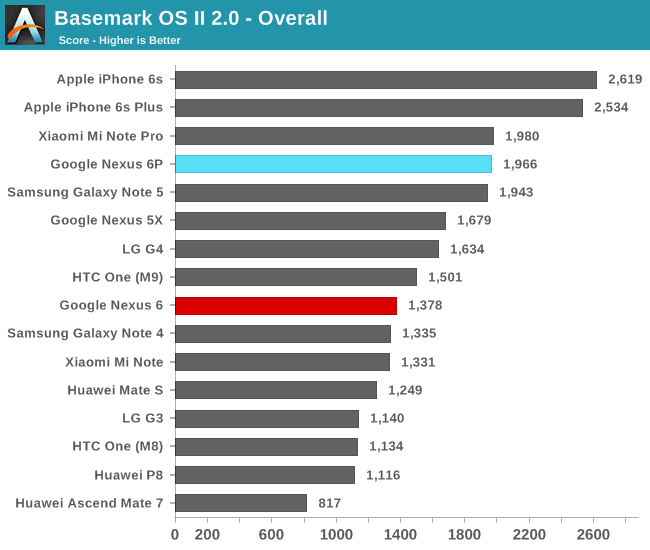
While I’m not a great fan of overall aggregate benchmark scores, we still see the Nexus 6P among the top of today’s currently available Android devices.
Moving on to PCMark from Futuremark, we’ll use a suite of tests that not only try to mimic real-world usage patterns, but actually make use of APIs that we currently find in use by many day-to-day applications.
Starting with the web browsing test we find the application use Android’s built-in WebView container which relies on OS-dependent components.
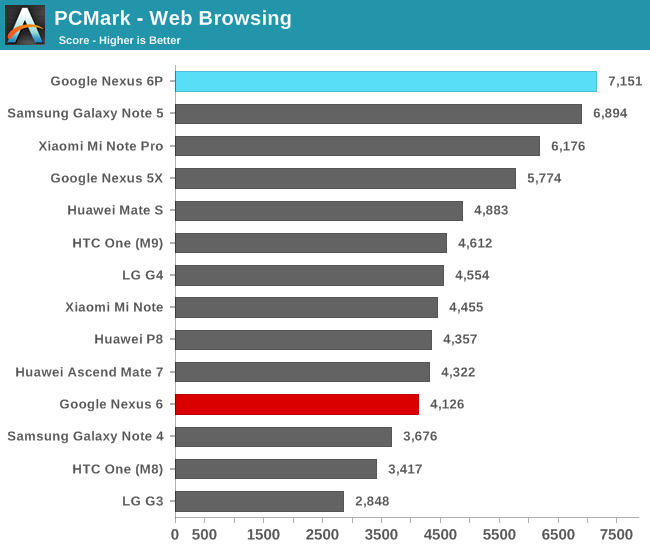
Here we see the Nexus 6P lead performance, slightly beating the Note 5. We’re also likely seeing advantages due to Android 6.0 as the Mi Note Pro, our other device with the Snapdragon 810 lags over a thousand points behind.

On the video playback score the Nexus 6P comes in towards the middle of the pack. The video test is a benchmark of both the video decoding hardware and software layers of the device, as well as the NAND speed, as fast seeking through the video is performed to test out how rapidly the device can resume playback.
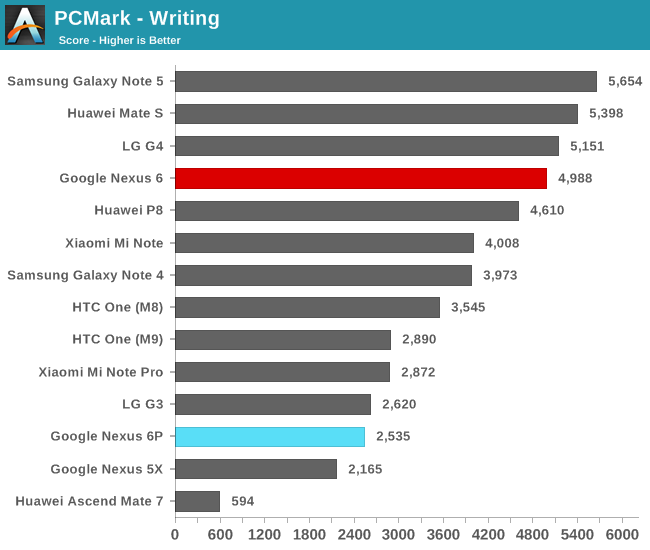
Now onto the writing test we come to one of the larger mysteries of the new Nexus 6’s performance. Both the Nexus 5X and the 6P seem to have large issues with PCMark’s writing test. The test itself consist of text manipulation and some file I/O, but most importantly it’s that this is purely a Java based test. Due to the way Android is architected, this means the code is handled and executed by the Android RunTime (ART). Futuremark have done a fantastic job in creating a test-case which is very sensitive to performance differences in the runtime.
At first when seeing these scores I thought that this was a side-effect of Android 6.0’s new big.LITTLE optimizations (which we’ll get back to in a later section), but even after turning those settings off the scores remained the same. After testing some other Java-based benchmarks I came to the conclusion that this has to be a software issue.
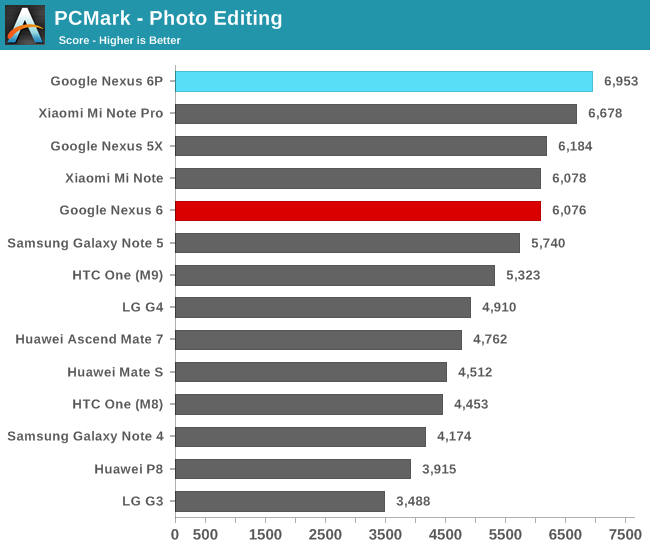
The photo editing uses RenderScript kernels to apply image processing on a set of pictures. With help of a powerful GPU the Nexus 6P performs top of the class
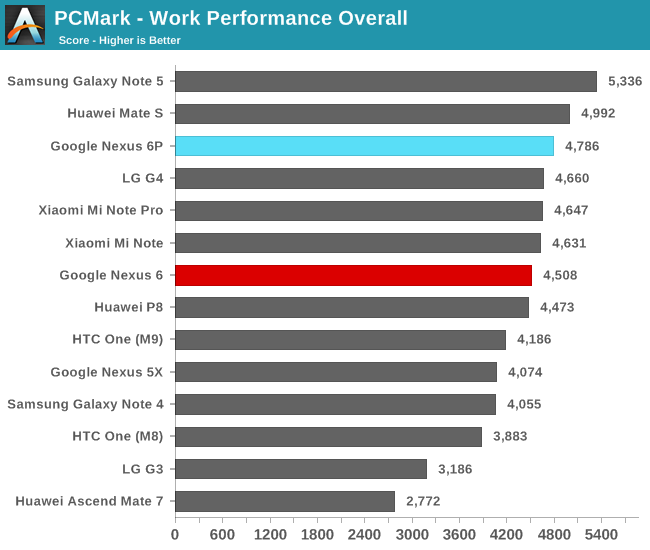
Due to the disappointing writing sub-score the Nexus 6P ends up third in the overall PCMark work performance score. Nevertheless, this is a good showing for the Snapdragon 810 device as it manages to slightly beat the Mi Note Pro and the HTC One M9.










219 Comments
View All Comments
grayson_carr - Thursday, December 17, 2015 - link
*car, not carerstuart - Thursday, December 17, 2015 - link
Then you have a non-standard compliant USB-C to USB-A cable. A USB-C charging device must indicate the maximum charging rate it supports using a resistor across the CC pins (A5 & B5). The values are 10K for 3A, 22K for 1.5A and 56K for legacy (0.5A). (This can be found in the USB specs, which are free to download from usb.org.)The issue is a passive USB-A to USB-C cable can't know what charging rate the device it connects will support, so the spec only allows on value for such adaptors - 56K, which means legacy (0.5A).
Your cable probably claims to support 3A. If it is connected to a cheap charger that is also non-standards compliant, your at risk of causing a fire.
Right now the USB-C market is a mess. I wanted to verify the USB-C to USB Micro A adaptor I purchased had the right resistor, and since the pins on USB-C are about as wide as a bees dick I purchased a USB-C breakout PCB (like this https://www.saikosystems.com/Web/images/Product/ic... ). It had no resistor at all, so I purchased a different brand. It was the same. I am pretty persistent, so I own 15 of them now. Not one is standards compliant.
grayson_carr - Friday, December 18, 2015 - link
I have the USB-A to USB-C cable from the Google Store... and Benson Leung, the Google employee who has been testing them, says it is spec compliant. Having a compliant cable does not mean you can only charge at 0.5A. It just means you can't charge at 3A like you can with a USB-C to USB-C cable.grayson_carr - Friday, December 18, 2015 - link
Also, your view of how USB cables work is too simplistic and wrong. If a USB-A to USB-C cable has a 56K pull-up resistor (as it should), it doesn't just automatically default to the base rate of 0.5A. It will defer to the USB BC 1.2 protocol to negotiate an appropriate current that both the charger and device can handle.SanX - Wednesday, December 16, 2015 - link
One thing bothered me in previous models inluding Nexus 6 was permanent focus "hoping" during video recording when you turn the camera like all cheapo camcorders do. That was present in all modes, the 1080 or 2160. This defect literally trash all your movies specifically visible and annoying in 2160. Must be a second camera module (they are cheap novadays, just a few dollars) which has to do hoping while the main one just do the final focusing if needed.JMC2000 - Wednesday, December 16, 2015 - link
I find the issue with the orientation of the back button a bit funny; personally, I despise having back on the right side of the navbar, and I'm right-handed. I can't stand the location of the back button on my Note 4, yet using on-screen buttons on it drives me insane.Whenever I run Cyanogen/ASOP roms, I always use this navbar layout (left to right):
Menu, Back, Home, Recents, Search
bogda - Thursday, December 17, 2015 - link
I am really dissaponted with direction Nexus devices took. Back in a days when I bought my Nexus 7 it was a very good device for a money. Now Google is dropping all reasons to buy Android vs iOS device. If I want iOS device I will buy one not, Android device with all annoying features of iOS devices and higher resolution display.And price in Europe that is 40% higher than in US is a cherry on the top.
oRAirwolf - Thursday, December 17, 2015 - link
Would you guys be so kind as to provide us with your testing methodology for determining NAND speeds? I know you have used Androbench in the past, but you mentioned that you used some custom settings. What settings are you using? I'd like to be able to compare the performance of some other of my devices that haven't been benched to get an idea how they compare.Thanks for your great review. I hope to see a Pixel C review soon :)
hfm - Thursday, December 17, 2015 - link
You guys seriously need editorial review. I got hung up on poor grammar and sentence structure a couple times in the review.Larry Endomorph - Thursday, December 17, 2015 - link
Agreed. More than "a couple times". Many more. And spelling errors.